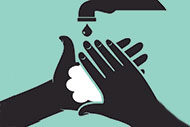Norovirus is known to cause gastroenteritis outbreaks worldwide. It is a hardy virus that can be quite stable in the environment, making it difficult to eliminate. While Norovirus is primarily transmitted via the fecal-oral route, preventing environmental transmission is particularly important in health care facilities.
In 2004, the Johns Hopkins Hospital noted a significant Norovirus outbreak at its 946-bed tertiary care hospital in Baltimore. From January through May 2004, 355 cases were identified — 265 health care workers and 90 patients — most of which were clustered in the coronary care and psychiatric units.
Multiple infection-control interventions were deployed, including proper education, screening and isolation precautions, hand hygiene and environmental cleaning. The hospital implemented aggressive cleaning measures using bleach. Clear cleaning instructions, describing the cleaning frequency and location or surface, were provided and incorporated by environmental services personnel.
One unit was closed for 24 hours while a deep environmental cleaning and disposal of items took place. Eventually the outbreak was contained, according to the article “Outbreak Management and Implications of a Nosocomial Norovirus Outbreak” in the September 2007 issue of Clinical Infectious Diseases.
The Centers for Disease Control and Prevention's (CDC’s) 2011 Guideline for the Prevention and Control of Norovirus Gastroenteritis Outbreaks in Healthcare Settings recommends routine environmental cleaning and disinfection in clinical and high-traffic areas for frequently touched surfaces such as toilets, faucets, handrails, bedrails, telephones, door handles and computer equipment.
These high-touch areas are recommended to be cleaned and disinfected with increased frequency (at least three times daily) during Norovirus outbreaks. During a health care facility outbreak of Norovirus, it is critical to follow cleaning and disinfection guidelines to control transmission effectively.
The Johns Hopkins Hospital was successful in controlling its Norovirus outbreak with robust infection prevention measures that included significant environmental cleaning and disinfection practices.
Deva Rea is clinical science liaison for PDI Healthcare, Orangeburg, N.Y. She can be reached at Deva.Rea@pdihc.com.






